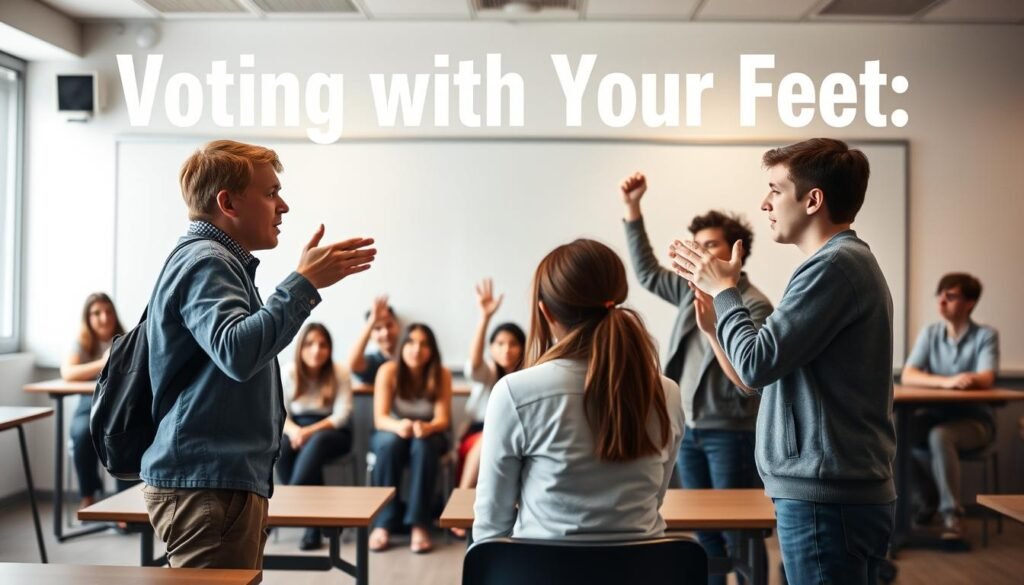Have you ever noticed your students with glazed-over expressions during a lesson? Keeping them interested can feel like an uphill battle. But what if there were proven strategies to transform your class into a hub of active participation and deeper learning?
At the 2023 Making Schools Work Conference, tech integration specialist Abby Thomas shared groundbreaking insights. Her approach blends tech tools with low-tech interactive methods to break out of traditional teaching boxes. These strategies are designed to boost critical thinking, knowledge retention, and overall academic outcomes.
From real classroom examples to versatile applications across grade levels and subjects, Abby’s methods are both practical and impactful. Whether you’re teaching math, science, or literature, these techniques can help create a more dynamic and inclusive learning environment.
Key Takeaways
- Abby Thomas’ strategies combine tech and low-tech methods for better engagement.
- These techniques work across different grade levels and subjects.
- Increased participation leads to improved critical thinking and knowledge retention.
- Real classroom examples make these strategies easy to implement.
- Versatile methods adapt to various teaching styles and student needs.
1. The Importance of Engaging Classroom Activities
When students are actively involved, their understanding of the material deepens significantly. Engagement is more than just keeping them busy—it’s about creating a connection to the learning process. Without it, lessons can fall flat, and students may struggle to retain information.
Why Engagement Matters in Learning
Research shows that when students are engaged, they perform better academically. For example, a study found that classes using regular engagement strategies saw a 32% improvement in grades. This is because active participation helps solidify knowledge in memory, a concept supported by cognitive science theories like dual coding.
Engagement also addresses different learning styles. Some students thrive with visual aids, while others prefer hands-on activities. By incorporating varied methods, educators can ensure every student feels included and motivated.
The Role of Teachers in Fostering Engagement
Teachers play a crucial role in keeping students engaged. Instead of being the sole source of information, they act as facilitators, guiding learners through interactive experiences. This shift from lecturer to facilitator can transform the classroom dynamic.
Professional development is key to mastering these strategies. Educators need training to effectively measure and improve engagement outcomes. By adopting a data-driven approach, they can refine their methods and create more compelling lessons.
2. Start with a Positive Mood: Visualizing Happiness
A positive start can set the tone for the entire class, making learning more effective. Neuroscience shows that a happy mood enhances information processing and memory retention. By beginning with a smile, you create an environment where students feel ready to participate and absorb new knowledge.
How to Begin Class with a Smile
One effective way to start is with a 3-minute visualization warm-up. Guide students to imagine their “happy place” using sentence stems like, “I feel calm when…” or “I smile when…”. This simple activity helps them transition into a positive mindset.
For reluctant participants, offer differentiation strategies. Some may prefer drawing their happy place instead of verbalizing it. The goal is to make everyone feel included and comfortable.
Using Tools Like Poll Everywhere for Word Clouds
Tech tools like Poll Everywhere can take mood-boosting to the next level. Create real-time emotion word clouds by asking a question like, “What word describes how you feel today?” This visual representation fosters connection and sets a collaborative tone.
An alternative is Mentimeter, which offers color-coded emotion mapping. Both tools provide data that can be tracked in mood journals or participation metrics, helping you refine your approach over time.
Cultural considerations are also important. Ensure your activities respect diverse backgrounds and interpretations of happiness. This thoughtful approach ensures every student feels valued and ready to learn.
3. Collaborative Brainstorming with Jamboard
Collaborative tools can transform how students interact and learn together. Jamboard, a digital whiteboard platform, is one such tool that fosters creativity and teamwork. It allows students to brainstorm, share ideas, and build knowledge collectively.
Setting Up a Jamboard Session
Getting started with Jamboard is simple. Teachers can create a new board and share the link with their students. The platform supports real-time collaboration, making it ideal for group work. Sticky notes, drawing tools, and image uploads add versatility to the experience.
Compared to other tools like Miro or Mural, Jamboard stands out for its ease of use and accessibility. Its integration with Google Workspace makes it a seamless addition to the classroom. Teachers can also access a library of templates tailored to different subjects, from STEM to humanities.
Creative Uses for Jamboard in the Classroom
Jamboard is perfect for collaborative annotation of texts or images. Students can highlight key points, add comments, and discuss their interpretations. Virtual gallery walks are another creative application, where students share their work and provide peer feedback.
Interactive KWL charts (Know, Want to Know, Learned) with sticky notes help students organize their thoughts. For larger classes, breakout room integration ensures everyone can participate. Teachers can also export Jamboard data for assessment purposes.
Accessibility features make Jamboard inclusive for special needs students. A cross-curricular example is historical timeline crowdsourcing, where students contribute events to a shared timeline. This approach encourages critical thinking and teamwork.
4. Voting with Your Feet: Interactive Debates
Interactive debates can bring lessons to life by encouraging students to express their opinions physically. This method, known as “voting with your feet,” allows learners to move around the room based on their stance on a question. It’s a dynamic way to foster critical thinking and active participation.

How to Organize a Voting Activity
Start by setting up the room with clear zones representing different answers or opinions. For example, one corner could mean “strongly agree,” while the opposite corner signifies “strongly disagree.” This spatial debate format helps students visualize their positions and understand others’ perspectives.
Use a continuum or quadrant system for more nuanced discussions. A continuum allows students to place themselves along a line, while a quadrant system divides the room into four sections for complex topics. Ensure you establish a protocol for respectful disagreement to maintain a positive environment.
Examples of Questions to Spark Discussion
Choose thought-provoking questions that align with your lesson. For instance, “Is genetic engineering ethical?” or “Should schools enforce strict social media policies?” These prompts encourage students to think critically and defend their positions.
Incorporate primary sources as evidence to deepen the debate. For shy students, consider a fishbowl variation where a small group debates while others observe. Digital tools like Slido can also be used for live polling, making it easier to track responses in real-time.
Wrap up with a metacognitive reflection by asking, “How did your position evolve?” This helps students analyze their thought process and reinforces learning. Recording debates can also be useful for flipped classroom analysis or cross-disciplinary applications like math concept confidence lining.
5. Gamify Learning with Flippity Tools
Games can be a powerful tool to enhance learning and keep students motivated. Flippity, a versatile platform, allows educators to create interactive games that make lessons more dynamic. From flashcards to scavenger hunts, this tool offers endless possibilities to transform traditional teaching methods.
Exploring Flippity’s Interactive Features
Flippity integrates seamlessly with Google, making it easy to create and share games. Teachers can customize games with school colors or mascots, adding a personal touch. The platform also includes a teacher dashboard for tracking student progress, ensuring accountability and growth.
One standout feature is the ability to design collaborative projects. Students can work together to create games, fostering teamwork and creativity. For example, a multiplication bingo game aligns with math standards while making practice fun.
Creating Custom Games for Your Class
Flippity’s toolkit includes templates for various subjects and grade levels. Teachers can adapt these to fit their curriculum, ensuring relevance. Cross-grade buddy gaming is another innovative approach, where older students mentor younger ones through shared game sessions.
For tech troubleshooting, Flippity provides clear guides to resolve common issues. Additionally, parents can extend the fun at home with game extensions, reinforcing learning outside the classroom. A case study showed a 40% increase in homework completion when Flippity was used, proving its effectiveness.
6. Random Name Generators for Participation
Random selection can level the playing field for all students. It ensures everyone has an equal chance to participate, fostering a more inclusive environment. Tools like Flippity’s Random Name Picker make this process simple and effective.
Using Flippity’s Random Name Picker
Flippity’s Random Name Picker is a versatile tool for educators. It allows teachers to create a list of student names and randomly select one for a question or answer. This method eliminates bias and encourages all students to stay prepared.
For added fun, themed pickers can be used. For example, historical figures or periodic elements can replace student names. This approach integrates learning with participation, making it more engaging for the class.
Encouraging Peer Interaction Through Random Selection
Random selection also promotes peer interaction. A “hot seat” variation, where selected students receive team support, builds collaboration. This method ensures no one feels isolated during participation.
Adaptive implementations are crucial for IEP students. Teachers can customize the tool to meet individual needs, ensuring inclusivity. Data analysis, like participation frequency charts, helps track progress and refine strategies.
Combining random selection with think-pair-share activities enhances learning. It encourages students to discuss ideas before sharing with the group. This approach fosters critical thinking and teamwork.
7. Team-Based Quiz Preparation
Team-based learning can transform how students prepare for quizzes and retain information. By working together, they not only reinforce their knowledge but also develop essential skills like collaboration and critical thinking. This approach makes quiz preparation more interactive and less intimidating.
Organizing Group Quiz Sessions
Start by dividing students into numbered groups. Assign roles such as researcher and presenter to ensure everyone contributes. Use a dice roll system to randomly select responses, keeping the session fair and engaging.
Modified quiz bowl formats with buzzers add excitement. Peer teaching requirements before competitions encourage students to explain concepts to each other, deepening their understanding. Cross-class tournament structures foster a sense of community and healthy competition.
Adding a Competitive Edge to Learning
Incorporate multimedia question types, from audio clips to 3D models, to make quizzes more dynamic. Community expert judging panels add authenticity and provide valuable feedback. A “blind quiz” variation, where students answer without knowing the topic, builds confidence and adaptability.
Longitudinal tracking of group progress helps identify areas for improvement. Emphasize a growth mindset in scoring to focus on effort and improvement rather than just correct answers. This approach ensures that learning remains the primary goal.
8. Gamify Your Quizzes with Blooket
Blooket brings a fresh twist to traditional quiz formats. This platform turns learning into an adventure, making it a favorite among educators and students alike. With its unique mechanics and interactive features, Blooket stands out as a game-changer in educational tools.
How Blooket Differs from Other Quiz Tools
Blooket’s Gold Quest mode is a standout feature. It combines risk and reward, encouraging students to strategize while answering questions. This mechanic keeps learners motivated and focused.
Other modes like Tower Defense and Racing offer variety. Tower Defense challenges students to build defenses based on correct answers, while Racing adds a competitive edge with speed-based gameplay. These modes cater to different learning styles and preferences.
Engaging Students with Self-Paced Games
Blooket supports asynchronous play, allowing students to complete quizzes at their own pace. This feature is perfect for homework or independent study. Students can also create custom avatars, adding a personal touch to their experience.
Power-up strategy workshops teach students to use in-game boosts effectively. This not only enhances gameplay but also reinforces critical thinking. Additionally, student-generated question banks foster ownership and deeper understanding of the material.
Blooket’s accessibility features ensure inclusivity for all learners. School-wide leaderboard systems promote healthy competition, while parental control settings provide a safe environment. By incorporating behavioral economics principles, Blooket keeps students engaged and motivated.
9. Think, Pair, Share: Encouraging Peer Learning
Think, Pair, Share is a simple yet powerful strategy to enhance learning. This three-step protocol encourages students to process information individually, discuss it with a partner, and then share their insights with the group. It’s a versatile method that works across subjects and grade levels.
Steps to Implement Think, Pair, Share
Start by posing a thought-provoking question or problem. Give students a moment to think independently. This step reduces cognitive load and allows them to organize their thoughts.
Next, pair students to discuss their ideas. Use sentence frames to support English Language Learners (ELLs) and ensure everyone can participate. Encourage cross-ability pairing to foster collaboration between students of different skill levels.
Finally, have pairs share their conclusions with the class. This step promotes accountability and reinforces learning. For digital variations, use breakout rooms in virtual settings to replicate the process.
Benefits of Peer-to-Peer Interaction
Peer learning builds confidence and communication skills. When students explain concepts to each other, they deepen their own understanding. Metacognitive reflection prompts, like “What did you learn from your partner?” help solidify this process.
Conflict resolution protocols ensure discussions remain productive. Cross-content connections, such as math journal swaps, extend the benefits beyond a single subject. Longitudinal tracking of skill development shows measurable growth over time.
Parents can also implement this strategy at home. Simple prompts like “Think about this, discuss it with a sibling, and share with the family” make learning a collaborative effort. This approach reinforces skills in a familiar environment.
10. Interactive Brainstorming Sessions
Interactive brainstorming sessions can unlock creativity and foster deeper understanding among learners. These sessions encourage students to think outside the box and collaborate effectively. By combining structured techniques with innovative tools, educators can create a dynamic learning environment.
Facilitating Group Brainstorming
Group brainstorming works best when structured with clear protocols. The design thinking approach is a great starting point. It involves empathizing, defining problems, ideating, prototyping, and testing solutions. This method encourages students to tackle challenges systematically.
Another effective technique is the SCAMPER method. It stands for Substitute, Combine, Adapt, Modify, Put to another use, Eliminate, and Reverse. This framework helps students explore creative solutions by reimagining existing ideas.
Using Technology to Enhance Brainstorming
Technology can take brainstorming to the next level. Virtual reality spaces allow students to visualize ideas in immersive environments. For example, they can design 3D models or explore historical settings for context.
AI-assisted tools are also gaining popularity. These platforms can generate ideas, suggest improvements, and even analyze trends. They’re particularly useful for entrepreneurial project planning and community problem-solving challenges.
Cross-school collaboration projects can further enrich brainstorming sessions. By connecting with peers from other institutions, students gain diverse perspectives. This approach also fosters discussions on intellectual property and patent research, preparing them for real-world challenges.
11. Buzz Sessions: Focused Group Discussions
Structured group discussions can drive deeper understanding and collaboration among learners. Buzz sessions, a timed and outcome-focused method, provide a framework for students to explore complex topics together. These sessions encourage active participation and foster critical thinking, making them a valuable tool for educators.
Setting Up Buzz Sessions in the Classroom
To organize a buzz session, start by dividing students into small groups. Assign a specific topic or question for discussion and set a time limit. This structure ensures focus and productivity. Use tools like fishbone diagrams to help students analyze cause-and-effect relationships within the topic.
Role-play debate formats can add variety. For example, students can simulate an industry panel, taking on different professional roles. This approach encourages perspective-taking and deeper engagement. For quieter students, establish protocols like “think time” before sharing to ensure everyone contributes.
Encouraging Collaboration and Critical Thinking
Buzz sessions thrive on collaboration. Cross-disciplinary problem-solving challenges students to apply knowledge from multiple subjects. This method not only reinforces learning but also builds transferable skills. Expert guest moderators can provide real-world insights, enriching the discussion.
Digital parking lot systems allow students to post questions or ideas for later review, ensuring no thought is lost. Peer evaluation rubrics encourage constructive feedback, fostering a culture of continuous improvement. Conference-style presentation prep helps students refine their communication skills while sharing outcomes.
By incorporating these strategies, buzz sessions become a powerful tool for fostering collaboration and critical thinking in the learning environment.
12. Exit Slips: Reflecting on Learning
Exit slips are a quick yet powerful way to gauge student understanding. These simple tools allow learners to reflect on what they’ve learned, helping teachers identify areas that need reinforcement. By incorporating exit slips into your routine, you can create a more responsive and effective learning environment.

How to Use Exit Slips Effectively
Start by setting aside a few minutes at the end of each lesson. Ask students to respond to a prompt or question related to the day’s material. This could be as simple as, “What was the most important thing you learned today?” or “What questions do you still have?”
Use data analysis protocols to review responses and identify trends. This helps you tailor future lessons to address common misunderstandings. For differentiation, offer multiple formats, such as written responses, drawings, or even emoji-based answers.
Tech tools like Google Forms and Pear Deck make it easy to collect and analyze exit slip data. These platforms also allow for creative formats, such as interactive slides or polls, keeping students engaged.
Examples of Exit Slip Questions
Effective questions encourage critical thinking and self-assessment. For example, “What strategy helped you solve today’s problem?” or “How could you apply this concept in real life?” These prompts go beyond simple recall, fostering deeper understanding.
For younger students, use visual prompts like, “Draw one thing you learned today.” For older learners, incorporate goal-setting questions like, “What’s one step you’ll take to improve your understanding of this topic?”
Longitudinal tracking of responses helps monitor progress over time. Share insights with parents to keep them informed and involved in their child’s learning journey. By implementing actionable feedback, you can ensure that exit slips lead to meaningful improvements.
13. Misconception Checks: Challenging Student Understanding
Misunderstandings can often go unnoticed, leading to gaps in learning. Identifying and addressing these misconceptions is crucial for ensuring students truly grasp the material. By using targeted strategies, educators can uncover hidden misunderstandings and help learners build a solid foundation of knowledge.
Identifying and Addressing Misconceptions
One effective technique is the “Circle the questions” method. Students mark questions they find challenging, allowing teachers to pinpoint areas of confusion. This approach provides immediate feedback and helps tailor instruction to meet individual needs.
Common core misconception banks are another valuable resource. These collections highlight frequent misunderstandings in subjects like math and science. By referencing these banks, educators can proactively address potential pitfalls in their lessons.
Peer explanation protocols also play a key role. When students explain concepts to each other, they often uncover and correct their own misunderstandings. This collaborative process reinforces learning and builds confidence.
Using Misconception Checks to Deepen Learning
Concept cartoons are a creative way to address misconceptions. These visual tools present scenarios with multiple perspectives, encouraging students to analyze and debate their ideas. This method fosters critical thinking and helps clarify complex topics.
Historical fallacy connections can also be enlightening. By examining past misconceptions in fields like science or history, students learn to question assumptions and think critically about information.
Digital misconception surveys offer a modern twist. These tools allow educators to collect and analyze data on student misunderstandings quickly. Refutation text creation, where students write explanations to debunk common myths, further solidifies their understanding.
Cross-cultural misconception analysis ensures inclusivity. By exploring how different cultures interpret concepts, educators can create more nuanced and effective lessons. NGSS application examples demonstrate how these strategies align with science standards, while intervention planning strategies provide actionable steps for addressing misconceptions.
14. Conclusion: Implementing Engaging Classroom Activities
Building strong relationships is the foundation of effective learning environments. By fostering trust and collaboration, educators can create spaces where students feel valued and motivated. This approach not only enhances participation but also supports long-term academic success.
For those new to these strategies, an implementation flowchart can guide the process. Start small, gather student feedback, and refine your methods. Professional learning communities offer valuable support, allowing educators to share insights and best practices.
Incorporating research-backed techniques ensures your efforts are impactful. Grants and community partnerships can provide resources for innovative tools. Remember to maintain a balanced approach, blending traditional and modern methods for optimal results.
Administrators play a key role in supporting these initiatives. Engage them early to secure buy-in and resources. Continuous improvement cycles help adapt strategies to evolving needs, ensuring sustained progress and positive outcomes.
FAQ
Why is student engagement important in the learning process?
Engagement helps students stay focused, retain information better, and develop critical thinking skills. It also makes lessons more enjoyable and meaningful.
How can teachers use Poll Everywhere to create word clouds?
Poll Everywhere allows students to submit responses in real-time, which are then displayed as a word cloud. This visual tool helps highlight common ideas and encourages participation.
What are the benefits of using Jamboard for brainstorming?
Jamboard enables collaborative brainstorming by allowing students to share ideas visually. It’s a great way to encourage creativity and teamwork in the classroom.
How can voting activities enhance classroom debates?
Voting activities, like moving to different sides of the room, make debates interactive. They encourage students to think critically and defend their viewpoints.
What makes Flippity a useful tool for gamifying lessons?
Flippity offers customizable games like flashcards and quizzes, making learning fun and interactive. It helps reinforce concepts in an engaging way.
How does a random name generator improve participation?
Tools like Flippity’s Random Name Picker ensure everyone gets a chance to contribute. It reduces bias and keeps students actively involved.
What are the advantages of team-based quiz preparation?
Group quiz sessions encourage collaboration and peer learning. They also add a competitive element, making studying more exciting.
How does Blooket make quizzes more engaging?
Blooket offers self-paced games with fun themes, allowing students to learn at their own speed while enjoying the process.
What is the Think, Pair, Share method, and why is it effective?
This method encourages students to think individually, discuss with a partner, and share with the class. It promotes deeper understanding and peer interaction.
How can exit slips help students reflect on their learning?
Exit slips provide a quick way for students to summarize what they’ve learned. They also give teachers valuable feedback on the lesson’s effectiveness.
What is the purpose of misconception checks in teaching?
Misconception checks help identify and correct misunderstandings. They ensure students grasp key concepts accurately and deeply.






